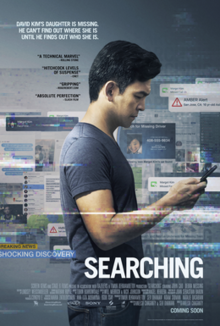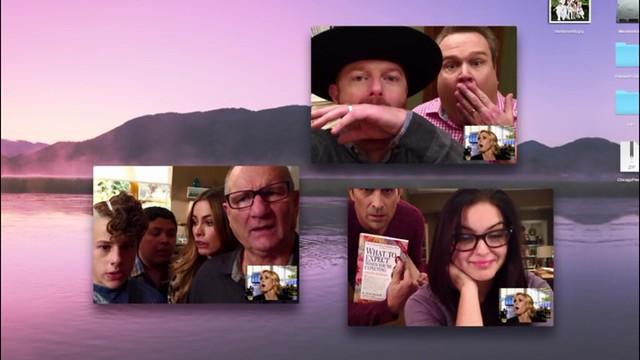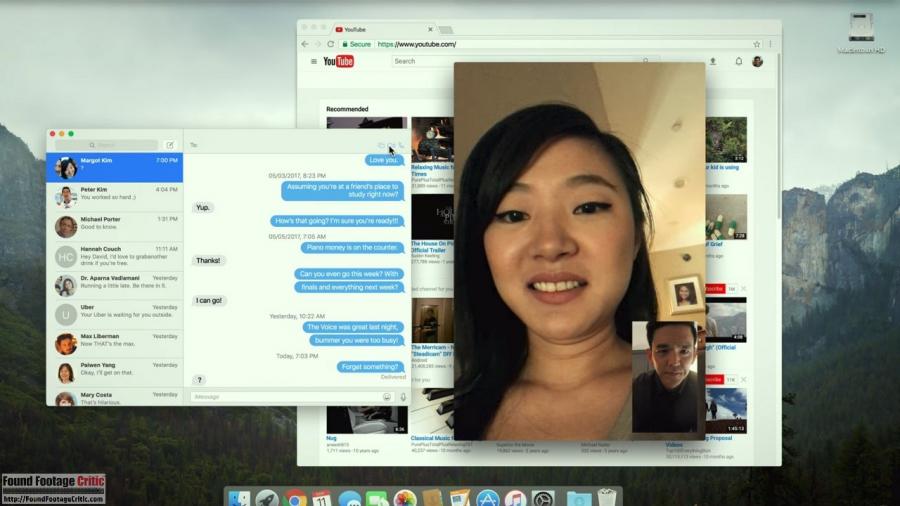
Stories to Tell in the Digital World: Connection Lost (2015) and Searching (2018)
The Modern Family episode "Connection Lost" (2015) and the film Searching (2018) have a lot in common. They both use digital technologies to tell stories about young girls gone missing. But a lot more is to be said for how these two hypermedial screen projects differ.
The first time I heard of Searching (2018) was when one of my college pals came for a visit. As we were walking down the street, he suddenly tapped on my shoulder, begging me to notice that the film’s poster was on a billboard outside a movie theatre. “The film is a hidden gem! You have to watch it!”, he exclaimed. Then he went on a five-minute spoiler-free speech about how well-made the film was. I immediately dismissed him. It wasn’t until a year later when it was on sale that I finally decided to give it a watch. I’ll say this now as I said right after I finished the film, “I’m sorry, Vince.”

Searching is an American production by Bazelevs Company and Stage 6 Films. Written by Aneesh Chaganty and Sev Ohanian, it was Chaganty’s feature film directorial debut. The reason why I did not give a second thought to the title during my first encounter with it was because it seemed like an ordinary story. The plot revolves around David, a widowed father, trying to find Margaret, his missing daughter. The story is just another fish in the ocean of Hollywood clichés. One would probably ask, “How about telling the story entirely through computer screens? Doesn’t that intrigue you?” My thought at the time was that it was simply a gimmick. We’ve already seen similar technique in "Connection Lost" (2015), the 16th episode in Modern Family’s season 6.
Connection Lost?
For those who have not given this long-lasting television series a try yet, Modern Family is a sitcom revolving around the everyday lives of three vastly different families in the United States. Representing the traditional American household are Phil and his wife Claire Dunphy, who gave birth to three children, namely Haley, Alex, and Luke. Following the Dunphy clan, there are Jay Pritchett, Claire’s father, and his second wife Gloria; together they raise one child, Manny, whom Gloria's son from her previous marriage. Finally, Jay’s son, Mitchell Pritchett, adopted a daughter named Lily with his spouse Cameron Tucker.
In "Connection Lost", Claire has to track down Haley from her MacBook with the assistance of the family before boarding her flight, since the latter is seemingly missing after a huge mother-daughter fight the day before. What ensues is a downward spiral of emotions led by a series of shocking revelations.
Connection Lost seems like an attempt to revitalize a show that has gradually lost its momentum.
The episode could be viewed as a work of hypermediacy, which, in other words, is the act of integrating various forms of media into a sensual experience. As Bolter and Grusin (1999) have suggested, it is about bringing the raw ingredients, such as images, sound, text, animation and video, together in any combination. Through combining these ingredients, it “tries to reproduce the rich sensorium of human experience” (Bolter and Grusin, 34). The episode falls under such framework because it not only includes footage from different mediums, e.g. computers, webcams, and televisions, but also multiple "windows" from different websites, such as FaceTime, Google Maps and Facebook, etc.
While the episode received fairly great reviews (9.5 on IMDb), the method seemed like an attempt to revitalize a show that has gradually lost its momentum rather than being an inherent story component. It is just there and does not add much to the story. Furthermore, it feels rather contradictory to the character of Claire, who was not a tech-savvy person in the slightest. Without some proper character development, it was inconsistent to see a suburban mom who did not know how to use a remote control before, now searching the Internet for clues on what happened to her daughter Haley and FaceTiming her family with ease.
It is also important to note that the similarities between "Connection Lost" and Searching go beyond the hypermedial framework that they both work in. Narratively speaking, they possess the same database aesthetics, i.e., they present databases for viewers and the main characters to progress through. Although they are still linear stories, in a sense they invite the audience to become active detectives who are able to help solve the missing cases. Simply put, it is an archival style which “prioritizes simultaneity over selection and probes the boundaries of contemporary conditions of attention” (Veel, 2011). These two titles can be seen as such since the audience goes on a journey with the main characters. Through the use of Internet databases, or the ones in their computer hard drives, we attempt to piece together the stories of how their children went missing.

Connection Lost (2015)
What makes Searching better?
To explore the follow-up question of what makes Searching better, I shall first turn to the examination of how many FaceTime footages were used in both works.
In "Connection Lost", it is apparent that there were several FaceTime materials in the episode. It is almost as if the computer screen were solely a glorified backdrop and the tab that shows up when a call is waiting to be connected serves as transitions from scene to scene. One can even argue the episode doesn’t necessarily have to be presented on Claire’s computer in its entirety, it also works if it simply showed the FaceTime footages as a montage of video chat interrogations.
Conversely, in Searching, FaceTime clips are utilized sparingly. In fact, if one looks closer, rather than being the entire story, the clips are mainly used for important expositions only. In this way, presenting the movie mainly through computers screens is justifiable since it implies there are other forces of technologies at work.
Simple text messaging is more humanlike in Searching and more machinic and soulless in Connection Lost.
To continue, I would like to inspect the other mediums at work in the two. Here the two works share some common ground in that the searches for their daughters both involve Google searching and Facebook account “hacking”. However, the most drastic difference emerges as one work further investigates how the main characters are shown to interact with the technologies, as I will illustrate next.
For starters, in "Connection Lost", after Claire’s multiple attempts at locating Haley are in vain, frustrated as she is, she puts on some music and starts a slideshow of old pictures of her daughter on the computer. While she is probably sobbing and stress-eating the popcorn she just bought for Cameron, suddenly her brother calls. Claire answers, and through Claire’s webcam we find out that sobbing and eating was exactly what she was doing before she picked up the call. We can guess this from her watery eyes and the popcorn on her hands.
I have to acknowledge that this is a well-crafted scene in that it first offered the audience room for their own interpretations, and later delivered an answer which also served as a punchline. Having said that, let’s turn to a similar scene in Searching.
Upon receiving the news that his daughter is more than likely deceased, David starts to search for memorial videos for Margaret’s funerals. In the library of videos, he stumbles upon an old video of Margaret. In the video, holding a card on her hand, she was happily jumping up and down on his bed, trying to wake him up on Father’s Day. He woke up reluctantly and took the card. A grin rose from the edge of his mouth, then it was revealed that it was a childlike drawing of David by Margaret, with the words “Best Dad Ever” written on top. Without showing what his facial expression is, the camera focuses on the computer screen, showing David dragging the video to the trash bin and deleting it for good.
Both scenes are beautifully constructed, yet the latter packs more of an emotional punch. In my opinion, there are two reasons why this is the case. Firstly, the contrast between agency comes into play. Imagine if Claire did not search for Haley’s childhood pictures on her own, but accidentally came across them when searching for information about the disappearance. Wouldn’t the whole scene be more emotional? Secondly, what if instead of showing Claire’s face and confirming the audiences’ predictions rather quickly by an abrupt phone call, subtle hints of watery eyes and popcorn residues on her hands were shown after she finally located her daughter? I prefer the latter since it would have been less in-your-face and would have provided the scene with more emotional strength.

Searching (2018)
Additionally, the demonstration of the simple act of text messaging was more humanlike in Searching. Early on in the film, David tries to reassure his daughter that she would pass her finals by texting, “I doubt you bombed it. You worked hard. And I’m proud of you.” Then the camera zoomed in on the bottom column of the message tab, showing David typing, “Mom would be too”, but eventually deciding not to send the text. Without showing David’s facial expression, the way he interacts with the technology reveals that he is a man who is still working through the loss of his wife. In comparison, the text messaging in "Connection Lost" lacks hesitation and rewriting, thus, looking more machinic and soulless.
Verdict
After carefully studying these two hypermedial screen projects, I cannot overlook the fact that "Connection Lost" was crafted three years earlier than Searching. It has, therefore, already brought a lot to the table at that time. That being said, my preference strongly leans towards the latter title. This is due to the fact that instead of treating telling a story through computer screens as a constraint, it makes effective use of the technology to take the audience on an emotional roller coaster. Moreover, the screenwriters’ acute observation on how people interact with the medium is truthfully translated onto the big screen. This allows the motion picture to bring tears to our eyes just by showing typing, clicking and browsing on a computer.
References
Bolter, J.D., & Grusin, R. (1999). Remediation: Understanding New Media. Cambridge, MA: The M.I.T. Press.
Veel, K. (2011). Information Overload and Database Aesthetics. Comparative Critical Studies, 8 (2-3), pp. 307-319.